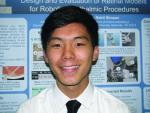By Elizabeth Johnston
Engineering faculty mentored nine of 22 high school students who published articles in the recently released third volume of Young Scientist, a research journal for students who have participated in research labs at Vanderbilt.

Zoe Turner-Yovanovitch explored a new method and device for separating bacterium from environmental samples into different ‘niches’ using a microfluidic device with small hexagonal chambers. As a student at Hume-Fogg Academic Magnet High School, Turner-Yovanovitch participated in the School for Science and Math at Vanderbilt (SSMV), which provides select public high school students in Nashville with a four-year, research-centered learning experience.
Nothing can beat the “real world experience” of creating methods and solving problems in a laboratory setting, says Turner-Yovanovitch. Read her article: Hexagonal-Chambered Microfluidic Device: A New Method and Device for Capturing and Culturing Environmental Microbes.
Her mentor was Assistant Professor of the Practice of Biomedical Engineering Kevin Seale. “The most important thing a student can gain from research,” he says, “is confidence in their ability to make meaningful contributions to science – individually and as part of a larger group.”
An integral part of that contribution for many SSMV students is writing an article for Young Scientist. “It demanded that we be able to present and defend all aspects of our research,” says Turner-Yovanovitch.
The Research Experience for High School Students (REHSS) is another Vanderbilt program dedicated to preparing the next generation of scientists. The intensive, six-week experience offers in- and out-of-town high school students the opportunity to conduct independent research projects in Vanderbilt labs.
Frank Jiang, an REHSS student from New Jersey, investigated retinal models used for the advancement of robot-assisted surgery in a Vanderbilt mechanical engineering lab.

Also published in the May issue of Young Scientist, Jiang says, “not only did writing the article make me broaden my understanding of the topic by reading a lot of other papers, it also forced me to categorize and organize all the work I had done into something recognizable and useful.”
His mentor was Associate Professor of Mechanical Engineering Nabil Simaan. Read Jiang’s article: Design and Evaluation of Retinal Models for Robotic Ophthalmic Procedures.
Both Jiang and Turner-Yovanovitch agree that writing for the publication was also a lesson in perseverance.
“Really, research is never truly finished, which can make this final research paper frustrating,” says Turner-Yovanovitch. “It teaches you to work with what you have.”
As with all peer-reviewed journals, papers submitted to Young Scientist undergo the scrutiny of fellow scientists in order to maintain the integrity of the scientific content of the journal. In this case, articles are reviewed by Vanderbilt postdoctoral fellows and graduate students.
“Scientific publication has become an overly complicated and drawn-out process,” says Seale.
“Young Scientist returns to the roots of publication and allows young people to simply communicate their methods and results to an interested audience with the aid of helpful peer review.”
Other students include Abhinav Goyal, Hume-Fogg; Melissa Guo, Martin Luther King; Jonathan Davies, Hillsboro High School; Zachary C. Anderson, Hume-Fogg; William R. Cox, Overton High School; Braxton L. Brakefield, Hillsboro High School; and Regan G. Givens, Pope John Paul II High School.
Participating engineering faculty include:
Melissa Skala, assistant professor of biomedical engineering
Nabil Simaan, associate professor of mechanical engineering
Nilanjan Sarkar, professor of mechanical engineering
Kevin Seale, assistant professor of biomedical engineering
Yaqiong Xu, assistant professor of electrical engineering
Scott Guelcher, associate professor of chemical and biomolecular engineering
Jason Valentine, assistant professor of mechanical engineering
Greg Walker, associate professor of mechanical engineering
The next submission deadline for Young Scientist is Fall 2013, and the fourth volume will be printed in May 2014.